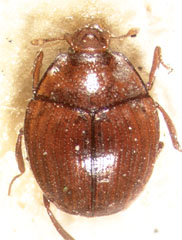Tribalinae
Michael S. Caterino- Epierus (~55 species)
- Plagiogramma (~30 species)
- Pseudepierus (2 species)
- Stictostix (~8 species)
- Parepierus (~26 species)
- Scaphidister (2 species)
- Tribalus (~50 species)
- Tribalasia (1 species)
- Idolia (~7 species)
- Sphaericosoma (1 species)
- Caerosternus (1 species)
Introduction
Tribalinae is a small subfamily, with only about 200 described species. Most of the neotropical species (Plagiogramma, Epierus, Idolia) are associated with dead wood. Species of the large Old World Tribalus are more varied, including some dung associates.
Characteristics
Tribalinae are usually easy to recognize through a combination of characters. The prosternal lobe is well developed and usually set off by a transverse ‘presternal suture’. It is always extended laterally as ‘alae’ which close the antennal cavities from beneath. These characteristics are shared with most Histerinae, and the two appear to be closely related (Caterino & Vogler, 2002), but Tribalinae possess a pair of labral setae, which Histerinae (by definition) lack.
Discussion of Phylogenetic Relationships
The relationships within Tribalinae (and the interrelationships with Onthophilinae) have been analyzed in an unpublished Ph.D. dissertation (Kovarik, 1994). Major changes in the composition of the two subfamilies have been proposed therein. However, the author is continuing to analyze his data (pers. comm.), and his revised conclusions are eagerly awaited.
References
Caterino, M. S., and A. P. Vogler. 2002. The phylogeny of the Histeroidea. Cladistics 18(4):394-415.
Kovarik, P. W. 1994. Phylogeny, chaetotaxy, and ecology of the Onthophilinae and Tribalinae. Unpublished Ph.D. Dissertation. Dept. of Entomology, Ohio State University, Columbus. 339 pages.
Mazur, S. 1988. New Neotropical histerid beetles with additional notes on the genus Plagiogramma Tasia in Curia. Polskie Pismo Entomologiczne 58:287-299.
Information on the Internet
Masahiro Ohara’s Histeridae home page: TribalinaeTitle Illustrations

| Scientific Name | Stictostix frontalis |
|---|---|
| Location | Australia |
| Specimen Condition | Dead Specimen |
| Image Use |
 This media file is licensed under the Creative Commons Attribution-ShareAlike License - Version 3.0. This media file is licensed under the Creative Commons Attribution-ShareAlike License - Version 3.0.
|
| Copyright |
© 2002

|
About This Page

Santa Barbara Museum of Natural History, Santa Barbara, California, USA
Page copyright © 2002
 Page: Tree of Life
Tribalinae.
Authored by
Michael S. Caterino.
The TEXT of this page is licensed under the
Creative Commons Attribution License - Version 3.0. Note that images and other media
featured on this page are each governed by their own license, and they may or may not be available
for reuse. Click on an image or a media link to access the media data window, which provides the
relevant licensing information. For the general terms and conditions of ToL material reuse and
redistribution, please see the Tree of Life Copyright
Policies.
Page: Tree of Life
Tribalinae.
Authored by
Michael S. Caterino.
The TEXT of this page is licensed under the
Creative Commons Attribution License - Version 3.0. Note that images and other media
featured on this page are each governed by their own license, and they may or may not be available
for reuse. Click on an image or a media link to access the media data window, which provides the
relevant licensing information. For the general terms and conditions of ToL material reuse and
redistribution, please see the Tree of Life Copyright
Policies.
- First online 07 March 2002
Citing this page:
Caterino, Michael S. 2002. Tribalinae. Version 07 March 2002 (under construction). http://tolweb.org/Tribalinae/9389/2002.03.07 in The Tree of Life Web Project, http://tolweb.org/








 Go to quick links
Go to quick search
Go to navigation for this section of the ToL site
Go to detailed links for the ToL site
Go to quick links
Go to quick search
Go to navigation for this section of the ToL site
Go to detailed links for the ToL site